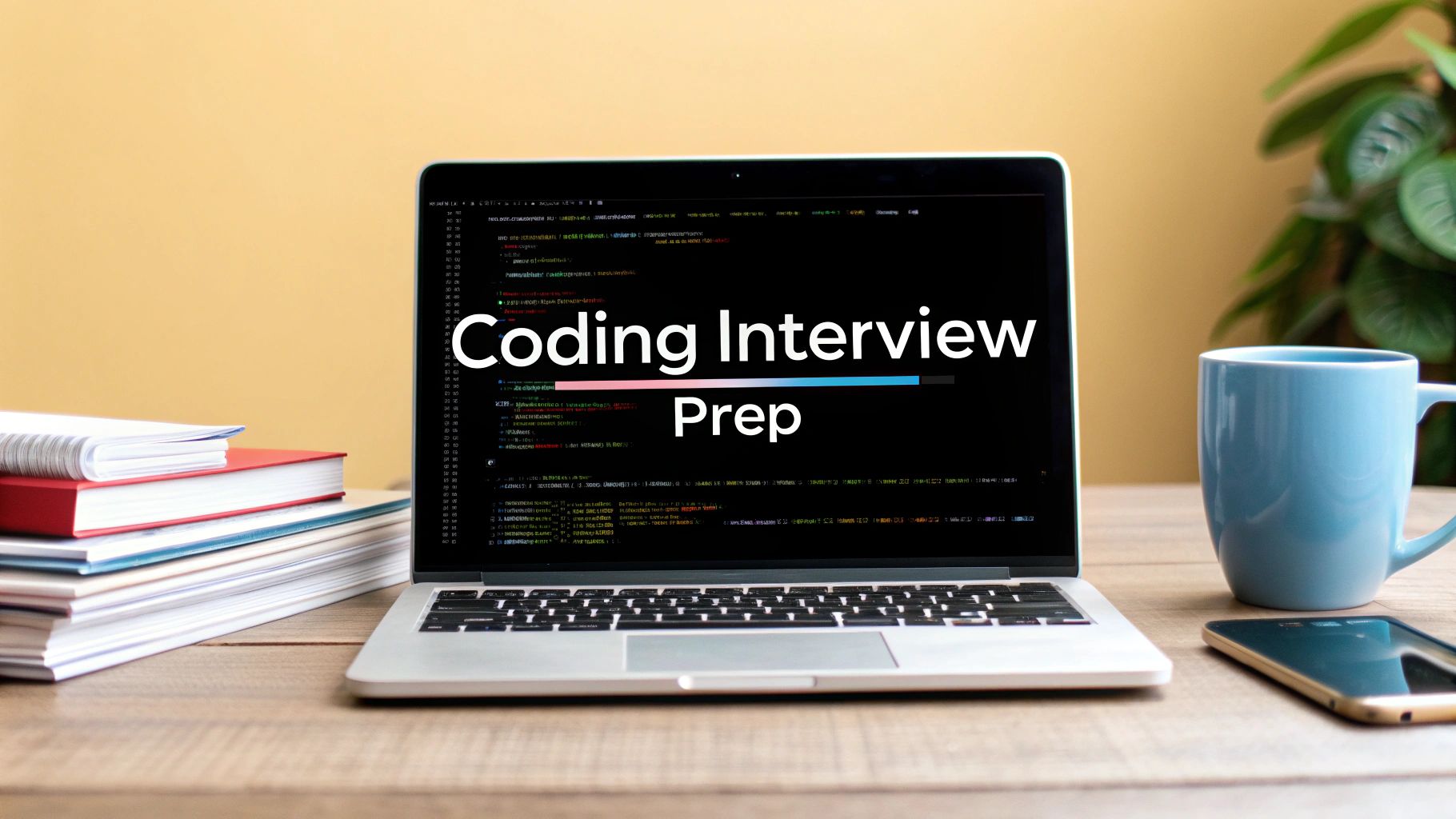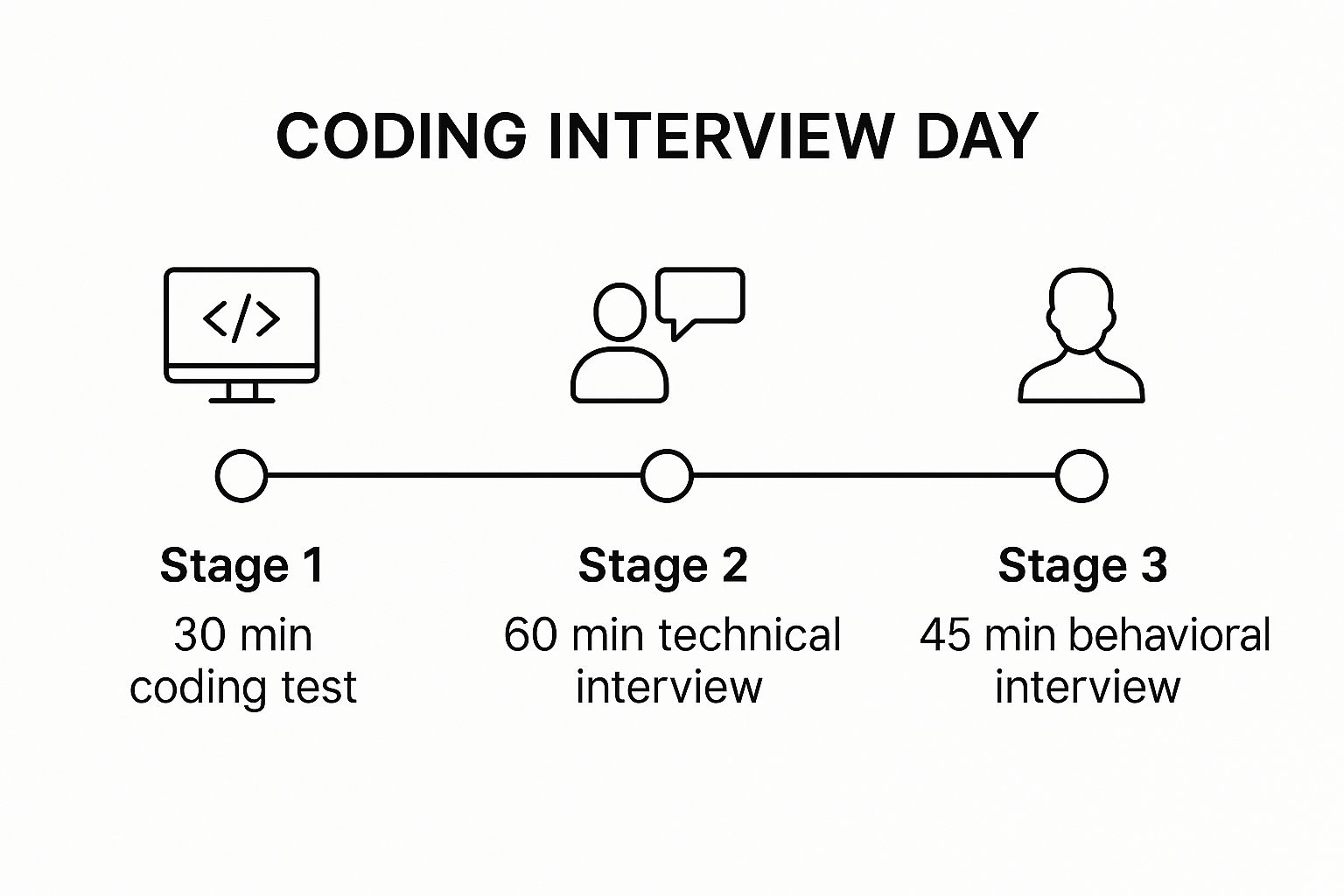How to Prepare Coding Interview: A Practical Guide to Acing It

To really nail a coding interview, you need a solid game plan. It’s not just about grinding through problems; it's about methodically building up your understanding of core data structures, algorithms, and, most importantly, problem-solving itself. Your success comes from deeply understanding the fundamentals—things like arrays, trees, and sorting—and then practicing until you can not only solve problems but also explain your thought process with confidence.
Building Your Technical Interview Blueprint
The path to acing a technical interview isn't a random walk through hundreds of coding challenges. It’s about creating a strategic, intentional plan that covers the right topics in the right sequence. Think of it as your personal curriculum, designed for one goal: showing off your problem-solving skills when it counts. A good blueprint keeps you focused, prevents burnout, and ensures you’re building real knowledge, not just memorizing solutions.
A winning strategy really comes down to three things:
- Deep Foundational Knowledge: You need to be fluent in the language of computer science. This is more than just knowing definitions; it’s about mastering data structures and algorithms.
- Strategic Practice: Practice with a purpose. Focus on spotting common patterns and really thinking through the trade-offs between different approaches.
- Communication Skills: Even the most elegant solution is worthless if you can't explain it. You have to practice talking through your logic, step by step, out loud.
Choosing Your Language Wisely
Your first big decision is picking a programming language for the interviews. While you can use almost anything, Python and Java are the most common for good reason. Python's clean syntax helps you write code faster, letting you spend more time on the actual algorithm. Java is also a fantastic choice, especially given its strong typing and popularity at big companies.
Honestly, the best language is the one you know inside and out. The last thing you want is to be fumbling with syntax or trying to recall a library function when the pressure is on. Stick to your strengths.
The Modern Interview Landscape
Preparing today is a different beast than it was a few years ago. In 2025, coding interview prep has had to keep up with how the interviews themselves have changed. Big Tech still loves its algorithm questions, but the bar is higher. It's not uncommon to face 'hard' level problems where you're expected to deliver clean, complete, and robust code—including error handling and input validation—all under the clock.
A typical interview day is a marathon, not a sprint. This visual gives you a good sense of the stages you can expect.

This structure shows that you’re being evaluated in multiple ways, from quick coding challenges to deeper technical and behavioral conversations. Each part of the process is testing a different aspect of your skill set.
Creating a Realistic Timeline
One of the biggest mistakes I see people make is trying to cram everything into a few weeks. That’s a fast track to burnout and only gives you a surface-level understanding. A much better approach is to set a realistic timeline that gives you space for deep learning. For most software engineering candidates, an 8-to-12-week plan is the sweet spot.
This timeline provides a structured 8-week plan, outlining key focus areas to guide your study schedule from fundamentals to advanced practice.
Essential Coding Interview Preparation Timeline
| Week | Primary Focus | Key Topics / Activities |
|---|---|---|
| 1-2 | Core Data Structures | Master Arrays, Strings, Linked Lists, Stacks, and Queues. Solve easy-to-medium problems. |
| 3-4 | Algorithms & Recursion | Focus on Sorting, Searching (Binary Search), and Recursion. Start thinking about Big O. |
| 5 | Trees & Graphs | Dive into Tree Traversals (BFS, DFS), Tries, and basic Graph algorithms. |
| 6 | Advanced Concepts | Tackle Dynamic Programming, Heaps (Priority Queues), and more complex Graph problems. |
| 7 | System Design & Mock Interviews | Practice system design fundamentals. Start doing mock interviews with peers. |
| 8 | Review & Refine | Revisit weak areas, solve company-specific questions, and do full-length mock interviews. |
This schedule ensures you build your knowledge progressively, solidifying one concept before moving to the next.
Remember, the goal isn’t just to pass an interview; it's to become a better problem-solver. A structured, patient approach builds lasting skills that will benefit you your entire career, not just for one day.
As you build out your plan, remember that in today's remote-first world, knowing how to prepare for a video interview is just as critical as your technical skills. Your technical blueprint is the starting point, and for more strategies to sharpen your approach, you can find more resources over on our blog at https://blog.parakeet-ai.com/.
From Theory to Practice: Solving Problems That Matter

Knowing the difference between a hash map and a binary tree is the starting block, not the finish line. The real test in any coding interview is whether you can apply that book knowledge to a messy, unfamiliar problem while the clock is ticking. This is where we stop just absorbing information and start actively building your problem-solving muscle.
I’ve seen too many candidates fall into the trap of thinking volume is everything. Grinding through 500 problems on autopilot is far less effective than deeply understanding and mastering 150 diverse ones. You’re aiming for quality, not quantity. The goal is to recognize underlying patterns, not just memorize solutions.
A Framework for Breaking It Down
When a complex problem lands in front of you, the natural instinct is to panic and start coding immediately. Don't do it. The best engineers I know all have one thing in common: they deconstruct the challenge first. A simple but powerful way to do this is with the UPER framework:
- Understand: Read the prompt. Then read it again. Start asking clarifying questions about edge cases, constraints, and the format of the inputs and outputs. If the problem is about subarray sums, ask, "Could this array have negative numbers?" or "What happens with an empty array?"
- Plan: Get on the whiteboard (virtual or real) before you type a single line of code. Sketch out the data structures you'll use, outline the algorithm in pseudocode, and talk through the logic. This is your chance to think about different approaches and their trade-offs.
- Execute: Once your plan is solid and you’ve walked your interviewer through it, then you start coding. Write clean, readable code that actually follows the plan you just made.
- Reflect: You’re not done when the code is written. Walk through your solution with a sample test case, step-by-step. Hunt for bugs. And, crucially, talk about the time and space complexity (Big O notation) of your final solution.
Following a methodical process like this shows the interviewer how you think—which, frankly, is more important than the code itself.
Your ability to break down a problem, articulate a plan, and analyze its efficiency is what separates a junior coder from a senior problem-solver. The code is just the final expression of that thought process.
Spotting Patterns, Not Just Problems
As you practice, you'll start to see that most interview questions are just dressed-up versions of a few core patterns. Instead of treating every problem as a brand-new beast, focus on categorizing it. This mental shortcut is an absolute lifesaver under pressure.
For example, if you see a problem asking for the "shortest," "fewest," or "closest" path in a grid or network, your brain should immediately scream Breadth-First Search (BFS). If it’s asking for all possible combinations or permutations, that’s a huge flashing sign for backtracking.
Here are some of the most common patterns worth mastering:
- Two Pointers: A classic for efficiently moving through an array from both ends. Perfect for finding pairs that sum to a target or checking if a string is a palindrome.
- Sliding Window: Incredibly useful for problems involving contiguous subarrays or substrings, like finding a maximum sum or the longest substring with certain properties.
- BFS/DFS on Trees and Graphs: Your go-to for anything involving traversal, connectivity, or finding paths. This is non-negotiable.
- Modified Binary Search: This is about applying the idea of binary search to problems that aren't just simple sorted arrays, like finding the minimum value that satisfies a certain condition.
When you focus on these patterns, you’re building a versatile toolkit. The next time a new problem comes up, you won’t be asking, "Have I seen this exact question before?" You'll be asking, "Which of my patterns fits this problem's structure?" That shift in thinking is a complete game-changer and a critical part of how to prepare for a coding interview effectively.
Using Modern Tools for Smarter Interview Prep
Learning how to prepare for a coding interview shouldn't feel like you're stuck in a dusty library, grinding away all alone. Technology gives us a huge advantage these days, transforming what used to be a lonely marathon into a much smarter, more connected process. The real key is to stop just working harder and start preparing smarter by weaving the right tools into your study routine.
AI-powered platforms have completely changed the game. Instead of waiting around for a friend to review your code, you can get instant, line-by-line feedback on everything from efficiency to style. This creates a really tight feedback loop that speeds up your learning and helps you fix bad habits before they stick.
Think of these tools as your own personal tutor. If you're stuck on a tricky concept like dynamic programming, an AI assistant can break it down with simple analogies or generate new practice problems focused specifically on your weak spots. This turns your prep from a generic checklist into a learning path built just for you.
Supercharge Your Workflow with AI
AI isn't a crutch; it's a force multiplier for your own efforts. When you hit a wall in the middle of a coding challenge, an AI pair programmer can suggest a different angle or help you debug a logic error—all without just handing you the answer. It’s great practice for the kind of collaborative problem-solving you'll do in a real engineering role.
Here’s how you can put these tools to work:
- Explain Tricky Code: Find an optimal solution on a site like LeetCode, paste it in, and ask the AI to explain the logic behind it, step-by-step.
- Find Your Blind Spots: Once you've written a solution, ask an AI tool to come up with tricky edge cases you might have missed, like empty inputs, negative numbers, or duplicates.
- Clarify Core Concepts: If you're wrestling with the Big O notation for a recursive algorithm, you can ask for a detailed breakdown of its time and space complexity.
The real goal here is to use technology to uncover your blind spots. An AI can point out an inefficient data structure choice or a subtle bug you might have otherwise missed. That kind of immediate, targeted feedback is exactly what you need to improve quickly.
The Power of Community and Collaboration
While AI is great for personalized help, you can't overlook the collective wisdom of the developer community. This is where a platform like Stack Overflow becomes absolutely essential. It’s more than just a place to find answers; it's a living library of real-world problems solved by engineers who have been in your shoes.
This shift toward using AI and community resources is happening across the entire tech industry. In fact, the Stack Overflow Developer Survey 2025 found that 84% of developers are now using or plan to use AI tools in their daily work. On top of that, 82% of developers visit Stack Overflow at least once a month, proving it's still a critical hub for learning. You can dig into more of these trends in the full 2025 survey.
Building a Modern Prep Toolkit
To get the most out of these resources, you have to be intentional. Don't just passively scroll through answers. Use these tools to actively test your understanding and fill in the gaps in your knowledge. You might even consider trying some of these AI Chrome extensions to make your research and studying a bit more efficient.
Your modern toolkit could look something like this:
- An AI Coding Assistant: A tool like ParakeetAI can give you real-time feedback and explanations right inside your editor.
- A Problem-Solving Platform: Stick with the tried-and-true sites like LeetCode or HackerRank for a steady stream of quality practice problems.
- A Community Hub: Make a habit of browsing Stack Overflow to see how seasoned developers discuss and solve complex algorithmic challenges.
- A Note-Taking System: Keep a digital notebook to track patterns you notice, save useful code snippets, and monitor your progress on different topics.
When you combine these elements, you create a powerful and dynamic system for your interview prep. This approach ensures you're not just memorizing solutions but actually building a deep, flexible understanding of the principles that matter.
Thinking Beyond Algorithms: System Design and Practical Skills
The technical interview isn't what it used to be. While a solid grasp of algorithms is still table stakes, companies are now looking for something more. They want to see if you can actually build things—if you can think through complex systems, tackle real-world coding problems, and work with a team.
This isn't just a hunch; the data backs it up. This year alone, 35% of major tech companies have shifted to practical coding challenges that mirror on-the-job tasks. And a whopping 60% of hiring managers now comb through a candidate's GitHub or project portfolio before even scheduling the first call. The game has changed, and you can get a deeper dive into these shifts in this analysis of future software engineering interviews.
This evolution from theoretical puzzles to practical problem-solving reflects a deeper change in what companies value. They're moving away from assessing candidates in a vacuum and toward evaluating skills that directly translate to building and maintaining their products.
The table below breaks down the difference in focus between the classic algorithm-heavy interview and the more modern, practical assessment.
Traditional vs. Practical Interview Assessment Focus
| Skill Category | Traditional Algorithm Interview | Practical Coding Assessment |
|---|---|---|
| Problem-Solving | Focuses on optimal solutions to abstract, isolated data structure and algorithm puzzles. | Focuses on pragmatic solutions to real-world problems like debugging or feature implementation. |
| Code Quality | Primarily evaluates correctness and Big O efficiency. | Evaluates readability, maintainability, testing, and understanding of existing codebases. |
| System Thinking | Rarely tested, or only in a dedicated system design round. | Often integrated, requiring candidates to consider how their code fits into a larger system. |
| Collaboration | Typically an individual performance, with the interviewer acting as a silent evaluator. | Often involves pair programming, assessing communication, and the ability to incorporate feedback. |
As you can see, the newer approach provides a much more holistic view of a candidate's abilities as an engineer, not just as a competitive programmer.
Cracking the System Design Interview
The system design round can feel like the final boss of the interview loop. The good news? It’s less about having a perfect, pre-canned answer and more about showcasing your thought process. The interviewer wants to see you navigate ambiguity and make smart trade-offs.
Before you even think about databases or APIs, you need to clarify the problem. Start by asking questions to nail down the scope:
- Functional Requirements: What absolutely must this system do? (e.g., "Users need to upload videos and see a personalized feed.")
- Non-Functional Requirements: What are the performance and reliability goals? (e.g., "The feed must load in under 200ms for 99% of users.")
- Scale and Constraints: What kind of load are we expecting? (e.g., "How many daily active users? What's the read-to-write ratio?")
Once you have clarity, start sketching out a high-level design. Think in building blocks: load balancers, web servers, databases, caches. But as you draw, talk through your decisions. Why a NoSQL database here instead of a relational one? What are the pros and cons of using a CDN?
The system design interview is a conversation, not a quiz. Your ability to articulate the why behind your decisions is far more important than arriving at a single "correct" architecture. Show them you can think like an engineer.
Hands-On Coding and Pair Programming
Get ready to get your hands dirty. More and more companies are throwing candidates into small, realistic coding scenarios. This could mean debugging a broken feature, adding a new endpoint to a sample API, or pair programming directly with an interviewer.
This format is specifically designed to test skills that a typical LeetCode problem can't touch:
- Code Comprehension: How fast can you get your bearings in an unfamiliar codebase?
- Debugging Skills: Can you systematically track down a bug instead of just guessing?
- Collaboration: How do you communicate your thought process and work with feedback?
The only way to get good at this is to practice. Find an open-source project you admire, clone the repo, and try to fix a bug from the issue tracker. Get comfortable reading code you didn't write. When you’re in the interview, remember to narrate your process. Explain what you're doing, what you expect to happen, and why.
Your Portfolio Is Your Proof
Never underestimate the power of your side projects. A polished project on your GitHub profile often says more about your abilities than a perfect performance on a 45-minute coding puzzle. It's tangible proof that you can actually build, ship, and maintain software.
A great project tells a story. It shows your passion, your ability to manage a project from start to finish, and your technical taste. Contributing to an established open-source project is even better—it demonstrates you can navigate a professional workflow, handle code reviews, and communicate effectively with a team. Your practical work is your resume in action.
Turn Theory into Practice with Mock Interviews

It’s one thing to solve a problem on your own time. It's a whole other ball game to do it while a senior engineer is watching your every move. An elegant solution is worthless if you can't explain how you got there.
After weeks of grinding algorithms and system design, this is where the rubber meets the road. Mock interviews are your single best tool for building real confidence, finding your blind spots, and polishing your delivery under pressure.
Learn to Think Out Loud
Interviewers aren't psychics. They need to hear your thought process, not just see the final code. "Thinking out loud" isn't about rambling; it's about narrating your problem-solving journey so the interviewer can follow along.
This is your chance to show them how you handle ambiguity, what you do when you hit a wall, and how you weigh the trade-offs between different approaches. Honestly, a candidate who clearly explains their thought process—even if they stumble a bit on the code—is often far more impressive than someone who silently produces a perfect solution out of thin air.
Here’s what your narration should cover:
- Clarify and Confirm: Start by restating the problem in your own words. Ask smart questions about constraints and edge cases.
- Explore Your Options: Talk through potential solutions. For example, "My first instinct is a brute-force approach, but that's probably O(n²). We can likely do better with a hash map to get our lookups down to O(1)."
- Code and Comment: As you write code, explain your intentions. "Okay, I'm setting up two pointers here to create a sliding window," or "This helper function will handle the recursion."
- Test and Verify: Once you have a solution, don't just stop. Walk through it with a quick example. "Let's trace this with the input
[1, 2, 3]to see how the variables change..."
A mock interview isn’t just a coding test; it’s a dress rehearsal for a technical conversation. Your goal is to turn your internal monologue into a clear, collaborative dialogue.
How to Structure Your Practice
To get the most out of your mock interviews, you need to treat them seriously. Find a partner—a friend, a mentor, or use a platform—and set it up like the real deal.
A good session involves both giving and receiving feedback. When you play the role of the interviewer, you get a much better sense of what they're looking for, which makes you a better candidate. I'd recommend aiming for at least one or two mock interviews per week in the final month before your real interviews.
Nailing Behavioral Questions with the STAR Method
Technical chops get you the interview, but behavioral questions decide if you’re a good fit for the team. You'll hear questions like, "Tell me about a time when..." They're looking for proof of how you've handled challenges in the past.
The STAR method is a tried-and-true framework for giving great answers.
- Situation: Set the scene. What was the project? What was the challenge?
- Task: What was your specific goal or responsibility?
- Action: What did you do? Describe the steps you took to handle the task.
- Result: What happened? Quantify the outcome whenever you can (e.g., "we reduced page load time by 15%," or "my refactor helped us ship the feature two weeks ahead of schedule").
Using this simple structure turns a vague story into a powerful example of your problem-solving, collaboration, and leadership skills. Combine this with your technical narration, and you'll be ready for anything they throw at you.
Common Questions About Coding Interview Prep
When you're grinding through interview prep, the same questions tend to pop up again and again. Getting solid answers to these can make all the difference, helping you focus your energy where it actually counts.
Let’s cut through the noise and tackle some of the most common things people wonder about on this journey.
How Many LeetCode Problems Should I Solve?
Everyone wants a magic number, but the honest answer is that quality trumps quantity. That said, a good target to aim for is around 150 to 200 problems. A solid distribution would be something like 50 Easy, 100 Medium, and 50 Hard problems. This range gives you enough exposure to see the common patterns without just spinning your wheels.
The real win isn't just getting the green "Accepted" notification. It's about going deeper. For every problem, can you explain the time and space complexity? Can you think of another way to solve it? That’s where the learning happens.
If you want to be strategic, zero in on mastering the big-hitter patterns:
- Two Pointers
- Sliding Window
- Dynamic Programming
- Graph Traversals (BFS/DFS)
A great sign of readiness is when you can confidently tackle a new medium-level problem and nail it within 30-40 minutes.
Which Programming Language Is Best for Interviews?
Simple: the one you're most comfortable with. The last thing you want is to be fumbling with syntax when your brain should be 100% focused on the algorithm.
With that said, Python and Java are popular for a reason. Python’s clean syntax is a lifesaver under pressure, and its powerful built-in data structures (like dictionaries and lists) let you express ideas quickly. Java is a rock-solid choice too, especially given its prevalence in large enterprise systems. C++ is great for performance-heavy tasks but can be a bit more cumbersome to write.
Your language is a tool, not a test. Pick the one that lets you think clearly and write code efficiently. Don't add stress by trying to cram a new language right before an interview.
What Is the Biggest Mistake Candidates Make?
By far, the most common mistake is passive learning. Too many people watch hours of video tutorials or read through dozens of solutions without ever writing the code themselves under pressure. This builds a false sense of confidence that crumbles the moment a real interview clock starts ticking.
The runner-up mistake? Forgetting that an interview is a conversation. You could code the most elegant solution in the world, but if you can’t explain your thought process, discuss trade-offs, and work with the interviewer, you'll probably get a "no."
To sidestep these traps, you have to do mock interviews. Regularly. It's the only way to practice the two skills you’re actually being judged on: coding and communicating, simultaneously.
How Do I Prepare for System Design with No Experience?
System design interviews can feel intimidating if you're early in your career, but they're absolutely something you can prepare for. The interviewer isn't looking for a perfect, production-ready blueprint; they want to see how you approach a big, ambiguous problem.
Start by getting comfortable with the foundational concepts:
- Scalability: How do you handle more users or data?
- Availability & Reliability: What’s your plan for when things inevitably break?
- Load Balancing: How do you spread out incoming requests?
- Caching: What data can you store temporarily to speed things up?
- Database Choices: When would you pick a SQL database over a NoSQL one?
A great way to learn is by studying high-level breakdowns of systems you use every day, like a URL shortener or the Twitter feed. Practice walking through a problem on a whiteboard (or a digital one), drawing boxes and arrows, and talking through the pros and cons of each decision you make.
Ready to put this into practice? ParakeetAI can act as your mock interview partner, giving you real-time feedback as you talk through your solutions. It's a great way to build the muscle memory for thinking out loud and refining your communication skills. Visit https://www.parakeet-ai.com to see how it can help you get ready for your next big interview.




